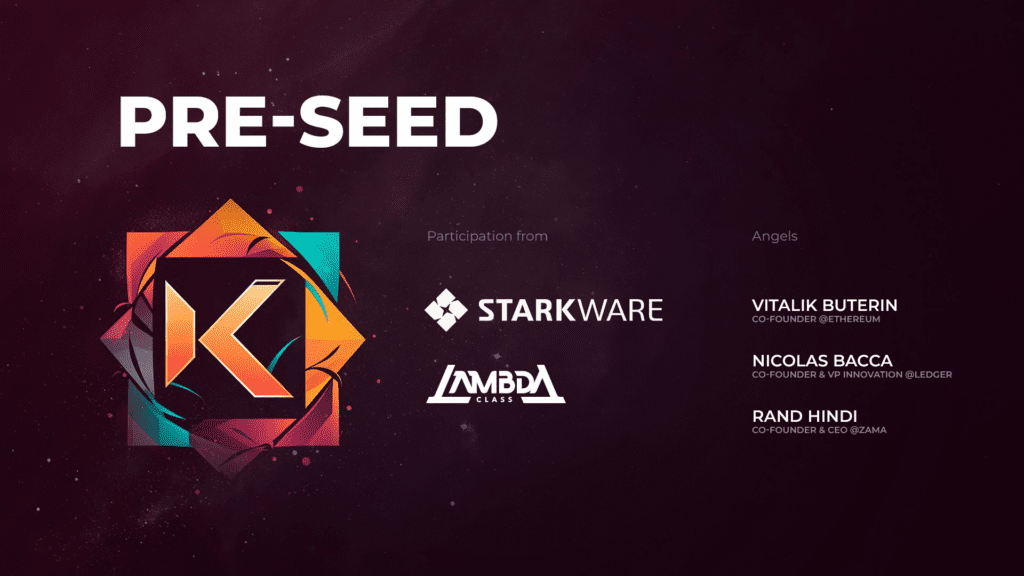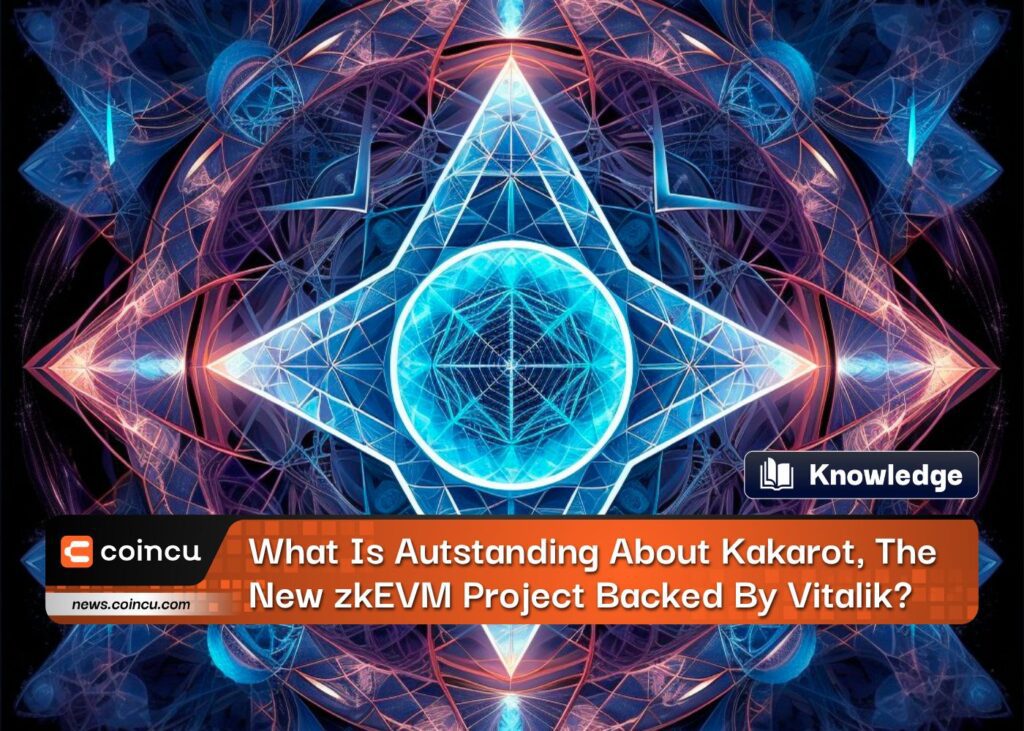Key Points:
- Kakarot zkEVM is paving the way for secure and scalable EVM compatible application development with StarkNet integration.
- The project has closed its pre-seed fundraising round, with the support of many big names such as Ethereum co-founder Vitalik Buterin.
- In the future, it hopes to link with native Starknet protocols and allow diverse protocols to communicate with one another.
Ethereum co-founder Vitalik Buterin has previously touted ZK-Rollup as a game changer that would soon overcome Optimistic despite its lengthy development path. Both are layer-2 solutions aiming to grow Ethereum by introducing off-chain computing while maintaining the main Blockchain’s security. Yet, the design of the phases and the degree of security change across them.
The Ethereum virtual machine (EVM) is the sole shortcoming of ZK-Rollup, making it impossible to execute decentralized apps (dApps) such as the DeFi protocol. This will soon change since ZK-Rollup is providing EVM compatibility for several of the large projects now under development, such as Scroll, Taiko, Polygon, and ConsenSys. One possible candidate to tackle this issue is Kakarot zkEVM.

Kakarot zkEVM, a Cairo-based Ethereum Virtual Machine (EVM), announced on June 2 that it had completed its pre-seed investment round. Among others who have contributed include Ethereum co-founder Vitalik Buterin, Ledger co-founder and VP of innovation Nicolas Bacca, and blockchain scaling business Starkware.
What is Kakarot?
Kakarot is a Cairo-based Ethereum Virtual Machine. That implies it can execute an EVM bytecode application on StarkNet, an Ethereum layer 2 scaling solution.
The EVM is a mature, well-defined virtual machine architecture. There are 142 opcodes, 9 precompiles, and a democratic method for updating these opcodes and precompiles. Would you suggest it in Cairo result in a “free” zkEVM, i.e. the scaling property of zero-knowledge as a direct result?
The notion quickly gained popularity in the Starknet community. In October 2022, Abdel, the leader of Starkware’s exploratory team and a member of the core Ethereum development team, began developing it. At about the same time, the Starknet open-source building community, with the assistance of Onlydust, launched a competing effort. While StarknetCC in Lisbon, the former absorbed the latter. Since then, the project has been incubated to take shape.
Cairo is a full language that is connected to CairoVM – Kakarot zkEVM is developed on top of CairoVM. Teams may use Kakarot zkEVM to design and deploy EVM-compatible apps.
Kakarot apps may be developed in the same way as Ethereum or Polygon programs are, using the Solidity programming language or any other EVM-compatible language. Users may communicate with deployed apps using traditional technologies such as Metamask or WalletConnect.
CairoVM uses polynomials and the ZK-STARK proof system to provide verifiable computing. The capacity of the zkEVM to create verifiable transactions, which lead to provable blocks, is what makes it useful. Kakarot is based on CairoVM, and every transaction performed on it is verifiable.
Teams may use Kakarot zkEVM to create and deploy EVM apps. Developers may use Kakarot to deploy any Solidity (or other EVM-compatible languages) exactly as they can with Ethereum or Polygon. Afterward, their end users may interact with the DApp using their regular tools (little fox wallet, wallet connection, etc.). The team added to the advantages of the integration:
“As a result of computing on another layer, gas costs are (asymptotically) exponentially lower than on L2, and performance (TPS) is higher. The scalability of rollups stacks and multiplies.”
Kakarot will allow compatibility with native Starknet protocols as well as protocol composability, such as merging TVL in DeFi with a user base in GameFi.
Fractal Scaling
Kakarot zkEVM may exist in many forms. For starters, it can be implemented as a smart contract on top of Starknet L2, appearing as a (expose) EVM on Starknet (Ethereum RPC, Ethereum transaction, etc.). The project, on the other hand, may be incorporated into the stack to install L3 zkEVM. Here is where the Madara sorter enters the picture.
A Layer 3 zkEVM may be developed by merging Madara (Starknet complete node) with Kakarot (EVM runtime). The stack consists of a Substrate full node that uses CairoVM as its execution engine and Kakarot as the smart contract runtime.
Kakarot transactions may be proved and validated on the settlement layer, allowing for EVM-compatible fractal scalability. Kakarot will be an EVM on Starknet Layer 2 in the initial phase, according to the project plan. Bringing Kakarot zkEVM to Starknet, according to the researchers, would offer up a slew of new options and broaden the Starknet ecosystem.
The project hopes to link to the native Starknet protocols in the future and enable other protocols to collaborate.
Roadmap
Phase 1: Kakarot zkEVM on Starknet – Introducing EVM to Starknet
Kakarot will initially appear in Starknet L2 as an onboarded EVM, allowing developers to deploy Solidity (or any EVM-compatible language) intelligence directly on Starknet using their familiar toolkits (Foundry, Hardhat, Wagmi, and so on).
Their customers will subsequently be able to communicate with their DApps using their standard toolchain (Metamask, Wallet Connect, etc.). Kakarot will provide the same developer and user experience as Polygon, Scroll, or Ethereum L1.
Phase 2: Kakarot x Madara – L3 zkEVM
Kakarot and Madara will be combined into a single stack that will handle L3 zkEVM as well as L4, L5, and so on. Teams will be able to install their zkEVM application chain on Starknet and use proof of validity to settle transactions.
Provability can perform the following functions: computation beneath the chain, calculation on the Layer, and chain verification.
L3s that use proof-of-validity contain an intriguing but underappreciated feature: the ability to decouple security from decentralization. Users may benefit from Ethereum L1’s security without the same amount of decentralization.
The gas fee is substantially cheaper than that of L2 due to the computation in another layer, and the performance (TPS) is greater. L2 is already far less expensive than L1. Scalability that is rolled up stacks and multiplies.
Proof verification and data availability (DA) may be separated to further decrease gas expenses. Starknet L2 can only be utilized as a proof verification layer, but new data availability solutions such as Celestia or EigenDA may publish transaction data.
Users may choose any option based on their security needs. Posting proofs and transaction data on Starknet is a more secure choice, but publishing transaction data utilizing DA solutions is a more cost-effective one.
Phase 3: Kakarot x Madara – zkEVM type 1
Type 1 zkEVM may also be enabled by combining Kakarot and Madara.
Cairo is used to building the Ethereum consensus rules inside the Madara x Kakarot full node so that the L1 consensus may be proven. Keccak MPT has replaced Pedersen Merkle Patricia Trie (MPT).
Kakarot will then be a type 1 zkEVM with the ability to testify to L1 blocks. This is a more complex use case that is contingent on Ethereum’s development (most notably Verge). Poseidon may replace Keccak as Ethereum’s preferred hash algorithm after Verge. This will assist the zkEVM team in becoming a type 1 since the key compatibility barrier for zkEVM is storage layout, i.e. implementing Keccak MPT in a provably and fairly affordable manner.
DISCLAIMER: The information on this website is provided as general market commentary and does not constitute investment advice. We encourage you to do your own research before investing.
Join us to keep track of news: https://linktr.ee/coincu
Harold
Coincu News





